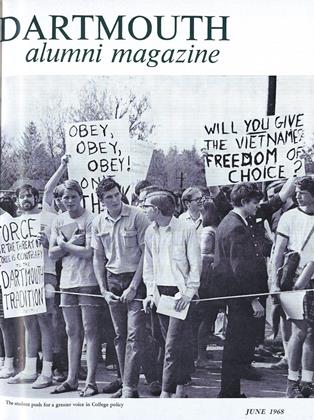. Edited byWilliam H. Davenport '29 and Daniel Rosenthal. New York: Pergamon Press,1968. 284 pp. $7.50.
This timely book reflects the growing na- tional awareness of the necessity to span the gulf between the engineering community and the humanists, and to reconcile the divergent historical views that each has had of the other. And it is a rewarding book for the insights offered into the history of technology, philosophy of science, the sociology of engineering, and engineering for the layman.
It is divided into four parts, each introduced by one of the two editors: "The View-point of the Humanist," "Attitudes of the Engineer," "Man and the Machine" and "Technology and the Future." The sections comprise essays by forty outstanding thinkers, all identified in a 'Who's Who' at the end of the volume. They range from the first century B.C. Roman architect and engineer, Vitruvius, and the 16th century's Domenico Fontana to Robert Heilbroner, John von Neumann, and Norbert Wiener. The 19th century is represented by Samuel Butler, Nicholas Leonard Sadi Carnot, and John Henry Newman with the remainder drawn - logically - from today. The juxtaposition of these essays emphasizes "the contrasts and comparisons,... similarities within apparent contradictions, and the inescapable time divisions of past, present, and future."
The thoughtful reader may derive the satisfaction of knowing that the debate about "two cultures" wanes; that perhaps the wheel is coming full circle and we, with Francis Bacon, can take all knowledge for our province.
 View Full Issue
View Full Issue
More From This Issue
-
 Feature
FeatureRETIRING FACULTY AND STAFF
June 1968 -
 Feature
FeatureThe Black Student at Dartmouth
June 1968 By Wally Ford '70 -
 Feature
FeatureVox Clamantis 1968
June 1968 By Chris Kern '69 -
 Feature
FeatureFour Steps Forward in Biology
June 1968 By PROF. RAYMOND W. BARRATT. -
 Feature
FeatureShark Authority
June 1968 -
 Feature
FeatureHeart Specialist
June 1968
JOHN HURD '21
-
 Books
BooksOLIVER GOLDSMITH.
February 1958 By JOHN HURD '21 -
 Books
BooksBITTERSWEET: COLLECTED VERSE.
JANUARY 1967 By JOHN HURD '21 -
 Books
BooksSCENERY OF THE WHITE MOUNTAINS.
MARCH 1971 By JOHN HURD '21 -
 Books
BooksFRANCE-NORD. VOLUME I. ARTOIS. ESTRÉE-BLANCHE. LA REGION D'AIRE ET AU-DELA. HISTOIRE. HABITANTS. HISTOIRES.
MAY 1972 By JOHN HURD '21 -
 Article
ArticleRed, Cav, Tuss, and The Ferocious Cherub
December 1973 By JOHN HURD '21 -
 Books
BooksTHE VISIONARY UNIVERSE PROPHECY.
June 1974 By JOHN HURD '21
Books
-
 Books
BooksTHE LIFE OF ARTHUR YOUNG, 1741-1821
November 1973 By DAVID ROBERTS -
 Books
BooksMISCHIEF
March 1934 By Eric P. Kelly -
 Books
BooksTHERE WAS A CROOKED MAN
January 1937 By H. M. Dargan -
 Books
BooksBriefly Noted
OCTOBER 1969 By J.H. -
 Books
BooksNEW ENGLAND SONNETS, ONE HUNDRED SONNETS SELECTED AND REVISED BY THE AUTHOR WITH A FOREWORD BY OGDEN NASH.
APRIL 1967 By JOHN HURD '21 -
 Books
BooksSEVENTY NEW POEMS.
JANUARY 1969 By JOHN HURD '21

